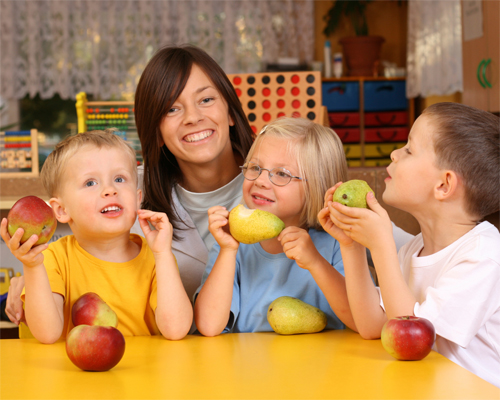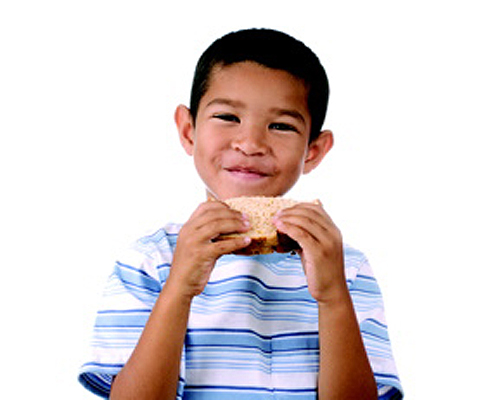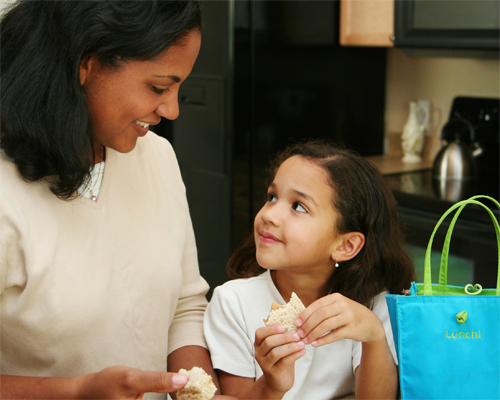
Fact Sheet FS1109
Food allergies are on the rise and it's likely that at some point you will have a child with food allergies in your group. A food allergy is an immune system response to a food that the body mistakes as harmful. Food allergies can affect people of all ages and are a very serious issue. As a leader of a youth organization, you are responsible for the safety of children in your care.
Remember that these are normal children who happen to have a food allergy. They do not want attention drawn to their allergy, they don't want people talking about them or it, and they don't want to be treated differently. They just want to have fun as part of the club, group, or team. You can keep these children safe by following these guidelines.
Get Information From the Parents
When working with children, you should always ask parents if their child has any food allergies. Find out what foods the child is allergic to and take time to understand parental concerns. Learn what needs to be done to protect the child. Parents will have specific advice on how to protect their child, including providing you with instructions on how to handle a food reaction and emergency medications. Older children may carry their own medications; however you should know where they keep it. When you have questions, ask the parents.
The Eight Major Food Allergens
While a person may be allergic to any food, these are the eight major food allergens:
- Milk
- Eggs
- Fish
- Shellfish (Examples: shrimp, lobster, crab, squid, and crayfish. Also mussels, clams, and oysters.)
- Tree nuts (Examples: almond, cashew, chestnut, pecan, walnut, hazelnut, pistachio, macadamia, and pine nut)
- Peanuts
- Wheat
- Soybeans
Any food made from these foods or that contains even traces of these foods could cause a reaction.
Food and Beverages
If your program serves snacks, ask parents to provide a list of safe foods and beverages. You may also ask them to provide a safe snack and beverage for their child. If you supply the food or beverage, read the food labels to be sure the food does not contain any food allergens. Do not allow children to share food. Every child's food restrictions will be different.
Safety First
First, always read the ingredient list on the food label to see if it includes any allergy ingredients before serving the food. An ingredient list can be found on the packaging of most foods. If a food does not include an ingredient list or was prepared by someone at home, do not serve the food to the child with food allergies. If the package has a statement such as "manufactured in a facility that also processes peanuts or another allergen," do not serve it to someone allergic to that food.
Next, always wash your hands thoroughly and clean all surfaces before and after they are touched by food to avoid crosscontact. Cross-contact is very dangerous. It occurs when an allergenic food comes in contact with another food or surface. If the person then eats the contaminated food or touches the contaminated surface, they could have a reaction. Last, try to keep crafts, games, and activities food-free.
Signs of a Reaction
Sometimes despite precautions, accidental consumption may occur resulting in a food allergic reaction. It is important to be aware of the signs and symptoms of an allergic reaction. The most common symptoms are a tingling sensation in the mouth, swelling of the tongue and the throat, difficulty breathing, hives, and vomiting. These symptoms can appear anywhere from within seconds to several hours after eating the food. A younger child may say things like "my tongue feels fat," "my skin is itchy," or "I can't breathe."
Minor symptoms may progress within seconds to anaphylaxis. Anaphylaxis is a life-threatening reaction resulting in difficulty breathing, swelling of the throat, severe low blood pressure, shock, and possible death. Take all reactions seriously and get the child medical attention.
Act Fast if a Reaction Occurs
Addressing a reaction quickly is important. Do not panic! Instead, deal with the reaction in a calm manner. Follow the parent's instructions on how to treat a reaction. They should have provided you with emergency medication such as epinephrine (Epi-pen™ or Twin Jet™). First, administer the emergency medication, then call 911, and last call the parents. Stay with and reassure the child until they get medical help.
Allergy-Friendly Snack Ideas
Always read the food label first!
- Fresh fruit and vegetables
- Plain popcorn (that does not contain cheese or caramel, both made with milk)
- Applesauce
- Gelatin (Jell-O™)
- Raisins and other dried fruit
- Baked corn chips with salsa
- Homemade trail mix (oat, rice, or corn cereals that do not contain wheat and dried fruit)
- Frozen fruit bars (that do not contain milk)
More Information
- foodallergy.org: information, advocacy, and research; many publications.
- njaes.rutgers.edu/foodsafety: Information about food safety, including food allergies.
- getmovinggethealthynj.rutgers.edu: Get Moving - Get Healthy NJ provides information on eating right and being active.
Mention or display of a trademark, proprietary product, or firm in text or figures does not constitute an endorsement by Rutgers Cooperative Extension and does not imply approval to the exclusion of other suitable products or firms.
October 2017
Copyright © 2024 Rutgers, The State University of New Jersey. All rights reserved.
For more information: njaes.rutgers.edu.
Cooperating Agencies: Rutgers, The State University of New Jersey, U.S. Department of Agriculture, and Boards of County Commissioners. Rutgers Cooperative Extension, a unit of the Rutgers New Jersey Agricultural Experiment Station, is an equal opportunity program provider and employer.



